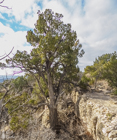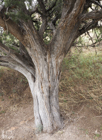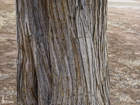
Typical distribution of a J. monosperma monoculture on the Painted Desert at Wupatki National Monument, Arizona [C.J. Earle, 2020.12.12].

This globular crown is extremely typical of young J. monosperma; a tree at Sunset Pass, Arizona [C.J. Earle, 2012.12.26].

An exceptionally large tree, over 1 m dbh and 15 m tall, at Palo Duro Canyon State Park, Texas [C.J. Earle, 2024.02.05].

An exceptionally old tree growing in limestone at Montezuma Well, Arizona [C.J. Earle, 2020.12.13].

Foliage detail on a plant near Cañon City, Colorado [C.J. Earle, 2022.05.24]

Seed cones and foliage on a tree east of Albuquerque, New Mexico [C.J. Earle, 2024.02.04].

Seed, seed cone, and foliage detail. Background is a 58mm diameter lens cap. Source, a tree at Palo Duro Canyon State Park, Texas [C.J. Earle, 2024.02.05].

Pollen cones and foliage on a tree east of Grand Canyon Junction, Arizona [C.J. Earle, 2012.12.25].

Typical trunk (single-stemmed, forking low) and fibrous bark on a tree at Bandelier National Monument, New Mexico [C.J. Earle, 2023.05.18].

Landscape dominated by J. monosperma at Black Mesa, Oklahoma; note the extensive snags from a fire a few years earlier [C.J. Earle, 2024.03.15]

Evidence of sapsucker activity on a large tree at Palo Duro Canyon State Park, Texas [C.J. Earle, 2024.02.05].

Conservation Status

Juniperus monosperma
(Engelm.) Sarg. (1896)
Common names
One-seed juniper, cherrystone juniper, New Mexico cedar (Peattie 1950), sabina (Adams 1993).
Taxonomic notes
Type: USA, Colorado, Cañon City, G. Engelmann s.n., 1874.09.24. Here is a syntype. This species is in Section Sabina, within the clade of western hemisphere serrate-leaved junipers, within the subclade of one-seeded junipers (J. angosturana, J. arizonica, J. coahuilensis, J. monosperma, J. pinchotii), as supported by multiple lines of molecular evidence. The clade itself seems to have originated about 10-15 million years ago (Miocene) (Uckele et al. 2021).
Synonymy:
Reports of hybridization with J. pinchotii have been refuted (Adams 1993). However, hybridization with J. scopulorum has been documented in the Guadalupe Mountains of New Mexico, which is quite surprising as these two taxa are as distant from each other as they could be within Section Sabina. The hybrids have J. monosperma chloroplasts, i.e. the pollen donor was J. monosperma, which otherwise is not known to occur within 5 km of the hybrid trees; and the nuclear DNA shows full heterzygosity at 18 loci shared by the two species, demonstrating a hybrid origin. The hybrids closely resemble J. scopulorum (Adams et al. 2020).
Description
Evergreen dioecious shrubs, or trees to 100 cm dbh and 15 m tall, usually with a single low-forking stem and a rounded crown of ascending to erect branches. Bark first smooth, later flaky, and on mature trees gray to brown, exfoliating in thin strips. Twigs erect, 4-6-sided, ca. 2/3 as wide as length of the scalelike leaves. Leaves green to dark green, abaxial glands elongate, fewer than 1/5 of glands (on whip leaves) with an evident white crystalline exudate, margins denticulate (at 20×); whip leaves 4-6 mm, glaucous adaxially; scalelike leaves 1-3 mm, not overlapping, or if so, by less than 1/4 their length, keeled, apex acute to acuminate, spreading. Seed cones maturing in 1 year, of 1 size, with straight peduncles, globose to ovoid, 6-8 mm diameter, reddish blue to brownish blue, glaucous, fleshy and resinous, with 1(-3) seeds. Seeds 4-5 mm (Adams 1993 and pers. obs. of trees at many places). See García Esteban et al. (2004) for a detailed characterization of the wood anatomy.
Distribution and Ecology
USA: Arizona, Colorado, New Mexico, Oklahoma and Texas at 1000-2300 m elevation on dry, rocky soils and slopes (Adams 1993). Other sources (Peattie 1950, Silba 1986) constrain the Texas range to the Panhandle, Big Bend and Edwards Plateau areas, and recognize an extension into Mexico (N Sonora and Chihuahua). Climate features an average annual precipitation of about 300 mm with half in summer, half in winter, and almost none in spring or fall. January temperature averages 2°C, and July averages 23°C (Johnsen 1962). Hardy to Zone 4 (cold hardiness limit between -34.3°C and -28.9°C) (Bannister and Neuner 2001). It is extremely well-adapted to dry environments, with reported rooting depths of as much as 60 m (Foxx and Tierney 1987), the deepest I have seen reported for any conifer. It is interesting, then, that it commonly occurs in a pinyon-juniper woodland with Pinus edulis, which has low drought tolerance compared to most pinyons. In response to precipitation, J. monophylla can take up more water than P. edulis and can do it at lower soil water potentials (Breshears et al. 1997). This, combined with deep rooting, gives J. monosperma significantly greater drought tolerance, and explains why the juniper dominates on dry sites, sometimes to the complete exclusion of the pine.
Distribution of the primary serrate-leaf-margin Juniperus taxa of western North America; J. monosperma shown in orange. Click on any marker for more information and a link to the source.
Due to the species' broad range, it occurs with a wide variety of codominants; the principal conifers include J. deppeana, J. osteosperma, J. pinchotii, Pinus cembroides, and P. edulis. Other common associates include various species of oak (Quercus spp.) and mesquite (Neltuma spp.), and the shrubs lechuguilla (Agave lechuguilla), Bigelow sagebrush (Artemisia bigelovii), fourwing saltbush (Atriplex canescens), alderleaf mountain-mahogany (Cercocarpus montanus), rubber rabbitbrush (Ericameria nauseosa), broom snakeweed (Gutierrezia sarothrae), winterfat (Krascheninnikovia lanata), catclaw mimosa (Mimosa biuncifera), skunkbush sumac (Rhus trilobata), Russian-thistle (Salsola kali), and various cacti including Cylindropuntia spp. and Opuntia spp. Associated grasses include Fendler threeawn (Aristida purpurea var. fendleriana), sideoats grama (Bouteloua curtipendula), black grama (B. eriopoda), blue grama (B. gracilis), bottlebrush squirreltail (Elymus elymoides), galleta (Hilaria jamesii), and tobosa (H. mutica) (Johnson 2002).
J. monosperma generally has low resistance to fire. Moderate intensity fires will kill most seedlings
and saplings, as well as a substantial fraction of mature trees. Regeneration is largely dependent upon seed transported from off-site. According to Johnsen (1962), fires were widespread and destructive in the early settlement era, before fire suppression became a standard management practice; also Leopold (1924) noted that fire scars were common on trees at that time. It is interesting that even at this early date, Leopold could discern the ecological effects of fire suppression and excessive livestock grazing, with resulting proliferation of young junipers on the landscape: "Previous to the settlement of the country, fires started by lightning and Indians kept the brush thin, kept the juniper and other woodland species decimated; and gave the grass the upper hand with respect to possession of the soil. In spite of the periodic fires, this grass prevented erosion. Then came the settlers with their great herds of livestock. These ranges had never been grazed and they grazed them to death, thus removing the grass and automatically checking the possibility of widespread fires. The removal of the grass relieved the brush species of root competition and of fire damage and thereby caused them to spread and "take the country.""
J. monosperma woodlands provide good cover for wildlife including songbirds, quail, wild turkey, pronghorn, elk, mule deer, and white-tailed deer (Johnson 2002). Like all junipers, J. monosperma relies on animals to disperse its seeds across the landscape. The cones are a seasonally important food source for a great many birds (e.g. northern flicker, Steller's jay, sage thrasher, mountain chickadee), as well as for mammals including chipmunks, deer mouse, pinyon mouse, woodrats, porcupine, rabbits, raccoon, gray fox, coyote, javelina, black bear, and mule deer; seed deposited from the scat of both birds and mammals shows high germination success (Johnson 2002, Stricklan et al. 2020). Mammals normally avoid browsing on J. monosperma foliage due to high concentrations of alpha-pinene in the foliage, which can cause neurotoxicity, mucous membrane irritation, diuresis, and nephritis in mammals. Woodrats (Neotoma spp.) have a high resistance to this toxin, excreting large amounts of alpha-pinene in their feces. Neotoma stephensi is a particularly dramatic example, being a specialist forager on J. monosperma; it voluntarily consumes twice as much J. monosperma foliage as the sympatric generalist species Neotoma albigula, and excretes four times as much alpha-pinene as N. albigula (Sorensen et al. 2004). Of course, a wide variety of insects are assoiated with J. monosperma; the known pests include Phloeosinus spp. bark beetles, juniper twig borer (Styloxus bicolor), wood borers (Buprestidae and Cerambycidae), juniper borers (Atimia spp., Callidium spp., Trachykele blondeli), spider mites (Oligonychus spp.), and spittlebugs (Aphrophora spp., Clastoptera spp.) (McMillin and Graves 2024). There seems to be no inventory of the non-pest insects associated with J. monosperma. It is also subject to Gymnosporangium spp. rusts, and it is parasitized by the mistletoes Phoradendron juniperinum and P. hawksworthii McMillin and Graves 2024).
Remarkable Specimens
American Forests (1996) cited the largest known tree as one in the Jicarilla Mountains of New Mexico with diameter 136 cm, height 9 m, crown spread 9 m. The largest specimen I've seen (photo at right) was about 100 cm dbh and 15 m tall.
Ethnobotany
Native peoples within its range would use strips of the fibrous bark to make saddles, breech-cloths, skirts, and sleeping-mats. They would also gather and dry the seed cones, grind them, and bake them into a kind of bread (Sargent 1896). In times of food shortage, the inner bark might be chewed, and the dried sap was commonly chewed. Medicinal uses included an infusion used by pregnant women prior to childbirth in order to relax the muscles; an infusion of the staminate cones used as a stomach tonic and in the treatment of dysentery; a poultice of the heated twigs bound over a bruise or sprain in order to reduce the swelling; the chewed bark applied to help heal spider bites and also as a dressing on burns; use of the seed cones as a diuretic; and use of the gum as a temporary filling in a decayed tooth (Moerman 1998).
The heavy, soft, close-grained, slightly fragrant wood is strongly decay-resistant. It was widely used for fencing and firewood (Sargent 1896), but has no particular economic value in the modern world. Much like its close relatives J. ashei and J. pinchotii, the principal modern economic significance of the species is its active invasion of rangelands, a phenomenon generally described as "juniper encroachment". See J. pinchotii for a detailed discussion of the phenomenon and the wide variety of often costly methods being used to control juniper on the landscape. J. monosperma, however, has also been planted for site rehabilitation, particularly on surface coal and uranium mines in the Southwest. A considerable literature documents the techniques needed for success in such rehabilitation (Johnson 2002).
Observations
The tree is readily seen on public lands throughout its range. Notable occurrences include Palo Duro Canyon State Park in Texas, where it occurs with abundant J. pinchotii and occasional J. ashei; its type locality in Cañon City, Colorado, where the species is abundant; Sunset Crater and Wupatki National Monuments in Arizona, where it occurs in some very scenic locales; and the Black Mesa Preserve, Oklahoma, where it occurs in one of the wildest parts of the state.
Remarks
The epithet means "single seed".
Citations
Adams, Robert P. 1993. Juniperus. Flora of North America Editorial Committee (eds.): Flora of North America North of Mexico, Vol. 2. Oxford University Press. This document is available online. Go to http://www.efloras.org, click on "Flora of North America," and search for "Juniperus."
Adams, R. P., S. T. Johnson, R. D. Worthington, and G. M. Ferguson. 2020. Hybridization between serrate leaf Juniperus monosperma and smooth leaf J. scopulorum in the Guadalupe Mountains, NM, USA: evidence from DNA sequencing and leaf essential oils. Phytologia 102(3):131–142.
American Forests 1996. The 1996-1997 National Register of Big Trees. Washington, DC: American Forests.
Breshears, David D., Orrin B. Myers, Susan R. Johnson, Clifton W. Meyer, and Scott N. Martens. 1997. Differential use of spatially heterogeneous soil moisture by two semiarid woody species: Pinus edulis and Juniperus monosperma. Journal of Ecology 85(3):289-299. https://doi.org/10.2307/2960502.
Foxx, Teralene S., and Gail D. Tierney. 1987. Rooting patterns in the pinyon-juniper woodland. Pp. 69-79 in R. L. Everett (comp.), Proceedings--pinyon-juniper conference; 1986 January 13-16; Reno, NV. General Technical Report INT-215. Ogden, UT: U.S. Forest Service, Intermountain Research Station. https://doi.org/10.2737/INT-GTR-215.
Johnsen Jr., Thomas N. 1962. One-seeded juniper invasion of northern Arizona grasslands. Ecological Monographs 32(3):187-207.
Johnson, Kathleen A. 2002. Juniperus monosperma. In: Fire Effects Information System, [Online]. U.S. Department of Agriculture, Forest Service, Rocky Mountain Research Station, Fire Sciences Laboratory (Producer). Available: https://www.fs.usda.gov/database/feis/plants/tree/junmon/all.html, accessed 2024.12.01.
Leopold, Aldo. 1924. Grass, brush, timber and fire in southern Arizona. Journal of Forestry 22: 1-10. https://doi.org/10.1093/jof/22.6.1.
McMillin, Joel and Andy Graves. 2024. Field Guide to Insects & Diseases of Arizona and New Mexico. https://www.fs.usda.gov/main/r3/forest-grasslandhealth/insects-diseases, accessed 2024.12.02.
Moerman. D. 1998. Native American Ethnobotany. Portland, OR: Timber Press.
Sargent, C. S. 1896. The silva of North America, V. 10, p. 89. Boston: Houghton Mifflin, accessed 2024.12.01. Sargent provides a detailed account followed by an excellent illustration.
Sorensen, J. S., C. A. Turnbull, and M. D. Dearing. 2004. A specialist herbivore (Neotoma stephensi) absorbs fewer plant toxins than does a generalist (Neotoma albigula). Physiological and Biochemical Zoology: Ecological and Evolutionary Approaches 77(1):139-148. https://doi.org/10.1086/378923.
Stricklan, Dave, Pradip Saud, Andrés F. Cibils, Robert L. Steiner, Douglas S. Cram, Kert Young, and Akasha M. Faist. 2020. Germination of one-seed juniper seeds distributed by different frugivore groups. Rangeland Ecology & Management 73(3):433–40. https://doi.org/10.1016/j.rama.2019.12.006.
Uckele, Kathryn A., Robert P. Adams, Andrea E. Schwarzbach, and Thomas L. Parchman. 2021. Genome-wide RAD sequencing resolves the evolutionary history of serrate leaf Juniperus and reveals discordance with chloroplast phylogeny. Molecular Phylogenetics and Evolution 156: 107022. https://doi.org/10.1016/j.ympev.2020.107022.
See also
Farjon (2005) provides a detailed account, with illustrations.
R.P. Adams' web site, juniperus.org.











